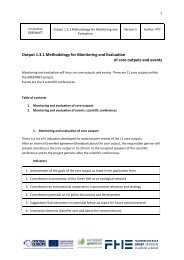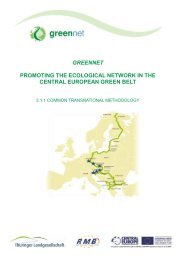The Green Belt as a European Ecological Network strengths and gaps
The Green Belt as a European Ecological Network strengths and gaps
The Green Belt as a European Ecological Network strengths and gaps
Create successful ePaper yourself
Turn your PDF publications into a flip-book with our unique Google optimized e-Paper software.
Cheryl de Boer, Hans Bressers<br />
RIVER RENATURALIZATION AS A STRATEGY FOR ECOLOGICAL NETWORKS<br />
RIVER RENATURALIZATION AS A STRATEGY FOR ECOLOGICAL<br />
NETWORKS<br />
Cheryl de Boer <strong>and</strong> Hans Bressers<br />
University of Twente<br />
CSTM – Twente Centre for Studies in Technology <strong>and</strong> Sustainable development<br />
PO Box 217, 7500 AE, Enschede, <strong>The</strong> Netherl<strong>and</strong>s<br />
c.deboer@utwente.nl, hansbressers@utwente.nl<br />
ABSTRACT<br />
Rivers in the Netherl<strong>and</strong>s often form linkages between cities. <strong>The</strong>se linkages also provide an<br />
opportunity to create natural linkage zones that connect nature <strong>and</strong> green spaces. This article portrays<br />
the collaborative <strong>and</strong> cooperative strategies which are being used by water managers, nature managers<br />
<strong>and</strong> provincial governments to accomplish significant ecological network development alongside<br />
projects aimed at river renaturalization. <strong>The</strong>se strategies provide an approach with which to address<br />
the complex <strong>and</strong> dynamic implementation setting in which such projects need to be realized.<br />
1 INTRODUCTION<br />
In the Netherl<strong>and</strong>s, there are three policy sets which we consider to directly support the<br />
greenbelt approach. Firstly, there is the set of policies in place for the protection of the<br />
remaining open space located between the larger cities in the west of the country which is<br />
referred to <strong>as</strong> the <strong>Green</strong> Heart. Secondly, policies exist to contain urban sprawl all over the<br />
country <strong>and</strong> endeavouring to maintain the rural nature of the countryside. And thirdly there<br />
are the policies which are connected to the EU Nature policies which enable the connection of<br />
existing yet fragmented nature are<strong>as</strong>. All three policy spheres are currently under pressure by<br />
debates on their value in comparison to development, decentralization <strong>and</strong> budget cuts.<br />
Nevertheless, their impact on Dutch l<strong>and</strong> use h<strong>as</strong> been remarkable. With respect to all three<br />
policies it holds that the sheer density of the Dutch population <strong>and</strong> its economic activities<br />
makes them both particularly necessary <strong>and</strong> especially hard to implement.<br />
In this article we concentrate on the policies related to the EU nature policies, <strong>and</strong> more<br />
specifically on the implementation strategies that are used to enable using rivers <strong>and</strong> river<br />
banks for their potential to serve <strong>as</strong> ecological linkage zones. We concentrate on the<br />
renaturalization of the Regge River, a 50 kilometer tributary river in the Dutch Vecht River<br />
b<strong>as</strong>in. With the exception of the River Rhine, the Vecht River is by far the largest crossboundary<br />
river between Germany <strong>and</strong> <strong>The</strong> Netherl<strong>and</strong>s. In the next section we provide some<br />
background on the relevant Dutch policy context, followed by a description of the Regge<br />
River c<strong>as</strong>e <strong>and</strong> a specific project <strong>as</strong> an example. In closing, the management strategies that we<br />
have identified are presented.<br />
2 GREENBELT POLICIES IN THE NETHERLANDS<br />
In the early 1900’s the majority of the “wild” nature in the Netherl<strong>and</strong>s consisted of<br />
raised bogs <strong>and</strong> heathl<strong>and</strong>s. Over the next seventy years, these are<strong>as</strong> were generally destroyed<br />
through l<strong>and</strong> developments which involved the implementation of ditches, dykes, fields, tree<br />
paths, etc. in order to support the incre<strong>as</strong>ing dem<strong>and</strong> for agricultural, residential <strong>and</strong> industrial<br />
l<strong>and</strong>s. Forested l<strong>and</strong> cover area did incre<strong>as</strong>e over this period, however it w<strong>as</strong> mainly through<br />
96




